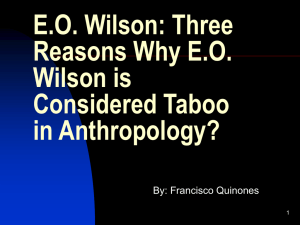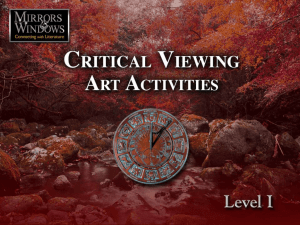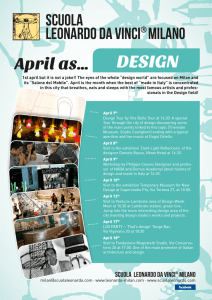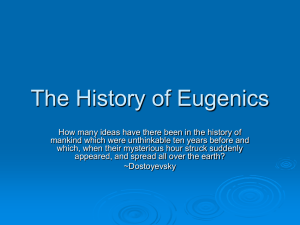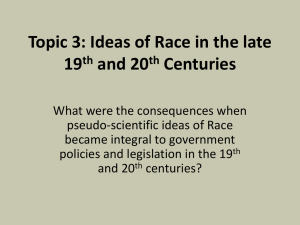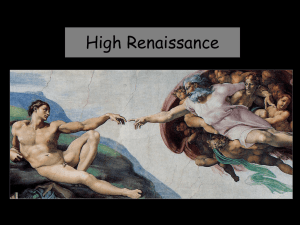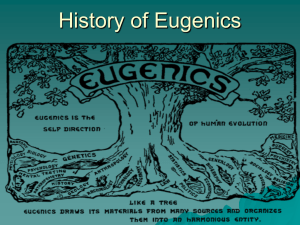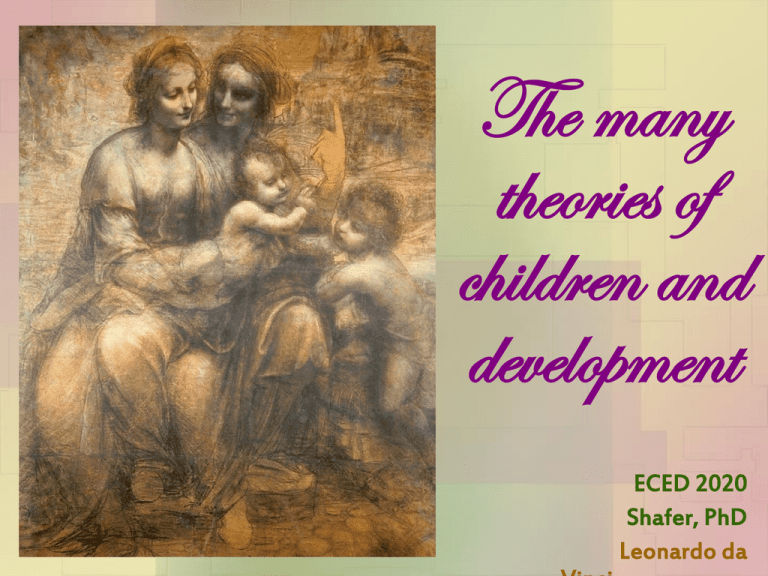
The many
theories of
children and
development
ECED 2020
Shafer, PhD
Leonardo da
Is human development a continuous
process or does it proceed by stages?
• CONTINUOUS – “a
process of gradually
augmenting the same
types of skills that were
there to begin with.”
(continually refining
skills) …
• STAGES (or
discontinuous) – “a
process in which new
ways of understanding
and responding to the
world emerge at
specific times.”
(developmental
milestones) …
NATURE vs. NURTURE, oh my.
• NATURE!!!
• Inborn biological
givens – hereditary
information received
from the parents at the
moment of conception
– DNA and stuff – all
things are
programmed (IQ,
temperament, etc. as
well as physical
characteristics …
• NURTURE!!!
• The complex forces of
the physical and social
world that influence
our biological makeup
and psychological
experiences before
and after birth –
products of our
environments – IQ etc.
are not static …
Aristotle & epigenesis
EPIGENESIS:
development
is a gradual process of
increasing complexity
Preformationism
• Believed that the
individual is FULLY
FORMED in the sperm of
the male.
• Those who believed
this were called
HOMUNCULISTS,
because that little
person in the sperm is
an homunculus.
• Do YOU believe this??
Preformationism, part 2
• Believed that an individual
is FULLY FORMED in the
ovum of the female.
• Those who believed this
were called OVISTS.
• The little man inside there?
Still an homunculus. Can you
dig it?
“If I have seen
further . . . It is by
standing upon the
shoulders of
Giants.”
--Sir Isaac Newton
Leonardo da Vinci
MEDIEVAL *500 – 1500 CE
• Children were
viewed as miniature
adults …as soon as
a child could live
without constant
attention & help of a
caregiver, the child
belonged to adult
society.
• Children worked like
adults, dressed like
adults, & could legally
be married, crowned,
or hanged like adults.
• ½ to ¾ of all
children died during
infancy
Medieval controversy …
Some scholars and textbooks say that this is not
true – that the people in this age did recognize
that childhood was a separate phase of life. You
must make your mind up who you believe.
Well??? Who DO you believe?
NEVERTHELESS …..
Medieval art …
Medieval …
• BLACK
DEATH or
Black Plague;
• 1347—1350
• three forms, the
bubonic,
pneumonic, &
septicemic
Not only were the children affected
physically, but also mentally. Exposure
to public nudity, craziness, & (obviously)
abundant death was premature. The
death of family members left the children
facing death & pain at an early age.
Parents even abandoned their children,
leaving them to the streets instead of
risking the babies giving them the
dreaded "pestilence". Children were
especially unlucky if they were female.
Baby girls would be left to die because
parents would favor male children that
could carry on the family name.
Marchione di Coppo Stefani
said this about the plague:
“There was such a fear that no one seemed to know
what to do. When it took hold in a house it often
happened that no one remained who had not died.
And it was not just that men & women died, but even
sentient animals died. Dogs, cats, chickens, oxen,
donkeys, sheep showed the same symptoms & died of
the same disease. And almost none, or very few, who
showed these symptoms, were cured. The symptoms
were the following: a bubo in the groin, where the
thigh meets the trunk; or a small swelling under the
armpit; sudden fever; spitting blood & saliva (& no one
who spit blood survived it). It was such a frightful
thing that when it got into a house, as was said, no
one remained. Frightened people abandoned the
house & fled to another."
“Science is best defined as
a careful, disciplined,
logical search for
knowledge about any &
all aspects of the universe,
obtained by the
examination of the best
available evidence &
always subject to
correction & improvement
upon discovery of better
evidence. What’s left is
magic. And it doesn’t
work.”
-- James Randi
Leonardo da Vinci
RENAISSANCE
1558 – 1603 CE
• "I have lost two or three suckling children, not
without regret, but without being much disturbed."
(Montaigne)
• Children were generally miniatures of their parents,
& were expected to dress, talk, & act as adults.
• The only difference between adults & children was
that children had no rights.
• BUT!!! In the middle & upper classes, regard toward
children grew during the Renaissance.
• KAZOWIE!!! Let’s see what we mean by that …
Renaissance improvements …
• "Children were meant to
play, to be shielded from the
worries & harshnesses of the
grown-up world, & to work
hard at their studies in
preparation for the time when
their presumably carefree
days would end."
Charles L. Mee Jr.
• Education during the
Renaissance became
increasingly more important
& popular.
“Think what a better
world it would be if we
all, the whole world,
had cookies & milk
about three o'clock
every afternoon &
then lay down on our
blankets for a nap.”
~Barbara Jordan
Sandra Bierman
Puritan views of children ~1600s
• In 1692, children were expected to
behave under the same strict code as
the adults—doing chores, attending
church services, & repressing
individual differences. Any show of
emotion, such as excitement, fear, or
anger, was discouraged, &
disobedience was severely punished.
Children rarely played, as toys &
games were scarce. Puritans saw
these activities as sinful distractions.
• "their Hearts naturally, are a
mere nest, root, fountain of Sin, &
wickedness." Benjamin
Wadsworth of Puritan children.
Puritan views …
• Children are born
evil & stubborn &
have to be civilized.
• Harsh, restrictive
child-rearing
practices to tame
the depraved child.
~Nature? Nurture?
“The purpose of
learning is growth,
& our minds, unlike
our bodies, can
continue growing as
we continue to live.”
--Mortimer Adler
Leonardo da Vinci
John Locke, 1632 -- 1704
• TABULA RASA (blank
slate)
• British philosopher
• View is strictly nurture,
yes?
• He regarded development
as continuous.
• Children are, when born,
nothing at all, & all kinds
of experiences shape their
characters.
John Locke: about school
“The child repeatedly
beaten in school
cannot look upon
books & teachers
without experiencing
fear & anger.” (He
strongly opposed
physical punishment.)
“I have a ‘carpe diem’
mug &, truthfully, at six
in the morning the
words do not make me
want to seize the day.
They make me want to
slap a dead poet.”
~Joanne Sherman
Diji
Jean Jacques Rousseau,
1712 – 1778
• Noble savages
• French philosopher
• Children are
naturally endowed
with a sense of right
& wrong & an innate
plan for orderly,
healthy growth.
~Nurture? Nature?
Rousseau, etc.
• NATURE
• His philosophy asserts
that adults should be
receptive to a child’s
needs.
• STAGE theorist
• MATURATION theorist
– he believed that there is
a genetically determined,
unfolding course of
growth.
“Somewhere on
this globe, every
ten seconds, there
is a woman giving
birth to a child. She
must be found &
stopped.”
~Sam Levenson
Mary Cassatt
Charles Darwin, 1809 -- 1882
• When 22 years old, he went
to South America aboard the
HMS Beagle & worked in the
Galapagos Islands:
• NATURAL SELECTION (or)
• SURVIVAL OF THE FITTEST
• All living creatures must
compete with each other in their
natural habitats, & it is the “natural
order” of things that those who
cannot compete will eventually die.
Likewise those who survive will
adapt to changes around them &
eventually pass these adaptive
characteristics & behaviors on
to their descendents.
Charles Darwin
• EVOLUTION: the complex
process through which
organisms change in response
to the pressures placed on
them by a changing
environment. Those that
cannot change & adapt
eventually die & they become
increasingly ill-equipped to
handle the new challenges in
their environment. Those that
change become stronger &
more adaptable.
Charles Darwin, continued
• TWO essential factors:
FIRST, the genes of parents
combine at RANDOM to
produce offspring. This
variation is an absolute
necessity for evolution to
take place. The SECOND
factor is that without change,
survival is impossible.
Explanations ……
• Through SEXUAL
REPRODUCTION there is
VARIATION.
• Offspring vary in ways that
allow them to meet the
demands of the environment in
which they, in turn, will live to
REPRODUCE SEXUALLY,
providing NEW VARIATION...
• DARWIN: NURTURE
“Man with all his noble
qualities … with his godlike
intellect which has
penetrated into the
movements & constitution
of the solar system … still
bears in his bodily frame
the inedible stamp of his
lowly origin.”
-- Charles Darwin, British
naturalist
Leonardo da Vinci
BABY BIOGRAPHIES!!!!
• 20th Century
• Darwin, Piaget, other
famous names
• Kept a day to day
description of how
their own children
developed.
Baby biographies . . .
• Can you think
of any reason
this might not
be a great way
to study child
development?
“Alice came to a fork in
the road.
'Which road do I take?'
said Alice.
'Where do you want to
go?' said the Cheshire cat.
'I don't know.' answered
Alice
'Then' said the cat 'it
doesn't matter.‘”
~Lewis Carroll
Mary Cassatt
G. Stanley Hall 1846 -- 1924
• NORMATIVE APPROACH
– “norms” for development
• American psychologist
• Development genetically
determined process that
unfolds like a flower …
(nature)
• Considered the “founder”
of the child-study movement.
Arnold Gesell, 1880 -- 1961
• Student of G. Stanley Hall;
worked on normative approach
• American psychologist;
educator; physician, writer,
Eugenics proponent *
• Inspired by Darwin
• ONTOGENY
• ONTOGENY: the
development of the individual
• RECAPITULATES: to
repeat, outline, summarize
• PHYLOGENY: the
development of the species
• NATURE!!!!!
RECAPITULATES
PHYLOGENY
* concerning adoption of babies
Gesell …
Human development progresses
through an orderly sequence &
this sequence is determined by the
biological & evolutionary history
of the species. The rate at which
any given child progresses
through the sequence, however, is
individually determined by the
child’s own genotype. Although
the rate of development can be
artificially altered, it cannot be
fundamentally changed.
Gesell, continued:
“A favorable environment (home or
otherwise) can, it appears, permit
each individual to develop his most
positive assets for living. An
unfavorable environment may
inhibit & depress his natural
potentials. But NO ENVIRONMENT,
good or bad, can so far as we know
change him from one kind of
individual to another.”
-- Frances Ilg, Louise Bates Ames,
colleagues of Gesell
If a man speaks in
the woods & there
is no woman
there to hear him,
is he still wrong?
Claude Monet by Auguste Renoir
Eugenics Movement
• First 6 decades of the 20th
century
• Taken to an extreme level
by Hitler – Holocaust
• Professors, medical
doctors, esteemed people,
great minds were eugenics
proponents
• Ultimately, 60,000
Americans were coercively
sterilized
Eugenics Movement
The term “eugenics” was coined by Francis
Galton in 1883. He was a cousin of Darwin.
(Darwin was staunchly against Eugenics.)
“eugenics” (from the Greek eugenes) "...good
in stock, hereditarily endowed with noble
qualities“
"Eugenics is a word with nasty connotations
but an indeterminate meaning."
Kelves says that by 1935 "...eugenics had
become `hopelessly perverted' into a
pseudoscientific facade for `advocates of
race & class prejudice, defenders of vested
interests of church & state, Fascists,
Hitlerites, & reactionaries generally”
Eugenics terminology …
• "Negative eugenics"
initiatives included
marriage restriction,
sterilization, or custodial
commitment of those
thought to have unwanted
characteristics.
• "Positive eugenics"
programs tried to
encourage the population
perceived as the "best &
brightest" to have more
offspring.
• "Positive macro eugenics
occurs when whole
cultural or ethnic groups
with 'desirable' genes are
given incentives to adopt
procreative methods that
give them a selective
advantage over other
groups...[while]...a
program with a micro
eugenic impact is one in
which an individual
couple & their extended
family are afforded
access to greater genetic
choice than is the norm."
Aye. There’s the rub …
• Gesell favored late adoption
of orphaned infants. He advised
that children should grow to at
least age 2 before being adopted.
Then their physical
characteristics could be matched
with adoptive parents. Children
with defects of any kind were
unadoptable. Until they were
adopted, the babies changed
caregivers every 6 months, so as
not to become attached.
“Every generation
rediscovers &
re-evaluates the
meaning of infancy
& childhood.”
-- Arnold Gesell
Leonardo da Vinci
Alfred Binet, 1857 -- 1911
• French psychologist.
• Asked by the schools in
Paris to develop a test to
determine which children
needed special education
services.
• So, he & his colleague,
Theodore Simon wrote the
FIRST IQ TEST!!!
IQ testing in America
The French test
was translated, &,
in 1916, first
administered in the
United States at
Stanford
University – THUS,
the Stanford Binet
IQ test.
“A guy goes to a
psychiatrist and says,
‘My brother needs some
help, doc. You see, he
thinks he's a chicken.’
The doctor says, ‘Well,
bring him in to see me.’
The guy says, ‘I'd do
that, but the problem is,
frankly, we need the
eggs.’”
~ Woody Allen
Sigmund Freud, 1856—1939
• Viennese physician
• PSYCHOSEXUAL THEORY
OF DEVELOPMENT
• What Mendel is to the study
of genetics & what Einstein is to
physics, Sigmund Freud is to
the study of the underlying
forces that influence human
development.
• Would likely be considered
NURTURE; stage theorist
Why we love Freud:
• Used cocaine to treat anxiety
& depression.
• Further used it as an eye
anesthetic.
• Preferred “free
association” to hypnotism.
• Trained Carl Jung &
Wilhelm Reich.
• Disrespected by peers
most of his life.
• Had heart disease &
cancer.
• Fled to London in 1938
from Austria, after the Nazi
invasion there.
• Psychoanalysis still
widely popular.
• Saw the human brain as
DYNAMIC, a fluid, energized
system.
• Three psychological
structures make up the mind: ID,
EGO, SUPEREGO.
Common Freudian terminology you
may have used recently …
Psychic energy Freudian slips
Transference
Preconscious
Psychoanalysis Psychosexual
Genital stage
Dream work
Displacement Condensation
Cathexis
Free association
Narcissistic
Anti-cathexis
Repression
Drives
Resistance Cathartic method
Death drive
Imago
Erotogenicity
Melancholia
Libido
Organ pleasure
Erogenous zones Oral stage
Superego
Unconscious
Pleasure principle
Id
Defense mechanisms
Ego
Phallic stage
Anal stage
Fixations Oedipus complex
Electra complex Penis envy
Castration complex
Eros
Castration anxiety Thanatos
Latency stage
Instincts
Freud’s psychosexual stages:
• ORAL (birth to 1 year) –
sucking, etc.
• ANAL (1 to 4 years) –
toilet training
• PHALLIC (4 to 6 years) –
Oedipus and Electra
complexes; penis envy,
etc.
• LATENCY (starts age 7) –
inhibiting erogenous
zones
• GENITAL (starts age 12) –
adolescence; sexuality
Maybe in order to
understand mankind, we
have to look at the word
itself, “MANKIND.”
Basically it's made up of
two separate words –
“mank” and “ind.” What do
these words mean? It's a
mystery, & that's why so is
mankind.
Pierre Auguste Renoir
Erik Erikson, 1902 -- 1994
• PSYCHOSOCIAL
THEORY
• Inspired by Freud
• Epigenesis (nature)
• Maturational
principle
• STAGE theorist
Erikson’s Psychosocial Stages
• TRUST vs MISTRUST
(0 to 1)
• AUTONOMY vs DOUBT
(1 to 3)
• INITIATIVE vs
SHAME & GUILT
(3 to 6)
• INDUSTRY vs
INFERIORITY
(6 to 11)
• IDENTITY vs ROLE
CONFUSION (or Identity
Diffusion)
(adolescence)
• INTIMACY vs ISOLATION
(young adulthood)
• GENERATIVITY vs
STAGNATION
(middle age)
• EGO IDENTITY vs
DESPAIR
(old age)
“The four stages
of man are
infancy,
childhood,
adolescence, &
obsolescence.”
-- Art Linkletter
Leonardo da Vinci
Ivan Pavlov, 1849--1936
• Russian physiologist
• Nobel Prize in
medicine in 1904
• Most behaviorism
theorists would be
NURTURE.
• Classical
conditioning:
– Dogs; bells, food,
salivation
Doggie conditioning
Conditioned reflexes
(1927):
• FOOD –
unconditioned
stimulus (UC)
• BELL –conditioned
stimulus (CS)
• SALIVATION –
unconditioned
response (UR)
Dad always
thought laughter
was the best
medicine, which I
guess is why
several of us died
of tuberculosis.
Michelangelo
John Watson, 1878–1958
• American psychologist
• Founder of Behaviorism
in United States
• Tested baby Albert with a
soft white rat
• Classical conditioning
• Got in loads of trouble for
this, by the way.
• Stimulus - response
Watson and baby Albert
Watson showed baby
Albert, 11 months old, a soft
white rat (live). At the same
time, there was a loud
bang. The rat was never
showed to the infant
without the bang. The baby
became extremely fearful
of the soft rat that had, at
first, caught his curiosity.
Famous quote by Watson
“Give me a dozen healthy infants, well-formed,
& my own specified world to bring them up in &
I’ll guarantee to take any one at random & train
him to be any type of specialist I might select –
doctor, lawyer, artist, merchant chief &, yes,
even beggarman & thief, regardless of his
talents, penchants, tendencies, abilities,
vocations, & race of his ancestors.”
(1925) (Does this sound NURTURE-Y?)
A good way to
threaten somebody
is to light a stick of
dynamite. Then you
call the guy && hold
the burning fuse up
to the phone. “Hear
that?” you'd say.
“That's dynamite,
baby.”
Michelangelo
B.F. Skinner, 1904--1990
Operant Conditioning
Behaviorism PLUS
REINFORCERS (which
increase behavior –
rewards) &
PUNISHERS (which
decrease behavior)
Skinner’s terminology
Also add NEGATIVE
REINFORCERS
(unpleasant or aversive
stimulus removed) &
EXTINCTION (decrease
in undesired behavior
until it was gone)
If you saw two guys
named Hambone &
Flippy, which one do
you think liked
dolphins the most?
I'd say Flippy,
wouldn't you? You'd
be wrong, though.
It's Hambone.
Norman Rockwell & Anton
Losenko
Albert Bandura, 1925-• Social Learning Theory
• IMITATION
• Explains how children
can learn to speak
seemingly without effort
• MODELING
• OBSERVATIONAL
LEARNING
Bandura’s social learning theory
Four processes
necessary for
observational learning:
1. Child must be
capable of attending to
the behavior being
modeled.
2. Child must be able to
retain in memory what
was observed
3. Child must have the
capacity to physically
perform the behavior
that was modeled.
4. Finally, the child must
have some sort of
motivation to imitate the
behavior – a
reinforcement or a
vicarious reinforcement
(observed in another)
“I am plus my
circumstances.”
-- Jose Ortega y
Gasset
Leonardo da Vinci
Jean Piaget, 1896--1980
• COGNITIVE DEVELOPMENT
THEORY
• Swiss cognitive theorist
• Stage theorist
• Children construct knowledge
as they interact with the
environment – adaptation
• Genetic epistemology
(epistemology is the study of
knowledge & justified belief)
Piagetian terminology
•
•
•
•
•
•
•
•
•
•
•
Adaptation
Schema
Assimilation
Accommodation
Equilibration
Organization
Egocentrism
Sensorimotor stage
Reflexive
Primary circular reactions
Secondary circular
reactions
•
•
•
•
•
•
•
•
•
•
•
•
Tertiary circular reactions
Symbolic representation
Preoperational stage
Concrete operational stage
Formal operational stage
Operation
Conservation
Object permanence
Egocentric speech
Classification
Seriation
Mental representation
Piaget’s Cognitive Development Stages
• SENSORIMOTOR STAGE -birth to ~ 2 years
• PREOPERATIONAL
STAGE -- 2 years to ~ 7 years
• CONCRETE OPERATIONAL
STAGE -- 7 years to ~ 11 years
• FORMAL OPERATIONAL
STAGE -- age 11 until life ends
I believe in making
the world safe for
our children, but
not our children's
children, because I
don't think children
should be having
sex.
• Raphael/Rembrandt
Lev Vygotsky, 1896--1934
•
•
•
•
Russian psychologist
Sociocultural theory
Children construct their own knowledge
Development cannot be separated from
its social context.
• Learning can lead development.
• Language plays a central role in mental
development.
• Zone of Proximal Development
Vygotsky, continued …
• Stage theorist
• Nurture theorist
• Scaffolding technique grew out
of Vygotsky’s work
• As did peer collaboration.
• Called egocentric speech
“private speech”
• Believed that make-believe play
is of great importance in
development.
• Vygotsky died of tuberculosis at
age 38.
Vygotsky’s stages …
• Natural or Primitive
Stage -- age birth to 2
• Naïve Psychology Stage
-- age 2 to 7
• External Signs or
Egocentric Speech -ages 7 to 12.
• Ingrowth -- 12 & beyond
• ALL STAGES based on
how language develops.
Quote from Vygotsky:
“Every function in the child’s cultural development
appears twice: first, on the social level, & later, on
the individual level; first, between people
(interpsychological) & then inside the child
(intrapsychological).”
(Marxist social theory is apparent in his theory:
emphasis first on culture, & then the individual.)
“Thought is not
merely
expressed in
words; it comes
into existence
through them.”
-- Lev Vygotsky
Leonardo da Vinci
Konrad Lorenz, 1903--1989
• Austrian ornithologist &
zoologist
• “founder” of ethology
• Winner of 1973 Nobel Prize
in Physiology or Medicine
with Niko Tinbergen & Karl
von Frisch
• Member of Nazi party for a
time
• When he accepted the Nobel Prize, he apologized for a
1940 publication judged to reflect Nazi views of science,
saying that “many highly decent scientists hoped, like I
did, for a short time for good from National Socialism, &
many turned away from it with the same horror as I.”
Konrad Lorenz & greylag goslings
• Lorenz observed the following
pattern that hatchlings showed
for the mother goose upon birth.
He called this “imprinting.”
• He separated the eggs from the
mother, & hatched them himself.
• The goslings all imprinted on
Lorenz, & showed the following
behavior for him.
• The critical timing of imprinting
is called a “sensitive period.”
If you ever catch on fire, try to avoid
looking in the mirror, because I bet that
will really throw you into a panic.
• Botticelli with Napoleon Bonaparte
Harry Harlow, 1905—1981
• American
psychologist
• Intrigued by love
• Worked with young
rhesus monkeys
• Considered an
ethologist also
• Inspired Bowlby &
attachment theory
Monkeys and surrogate mommies
ONE surrogate wire
mesh, warm face;
ONE surrogate soft
terry cloth, warm
face;
Bottle randomly
placed
Probably the
saddest thing
you'll ever see is
a mosquito
sucking on a
mummy. Forget
it, little friend.
•
Raphael and Renoir
John Bowlby, 1907--1990
• British psychoanalyst
• ATTACHMENT
THEORY
• Published “The
Nature of the Child’s Tie
to His Mother” in 1958.
• NOT well received at
British Psychoanalytic
Society
Attachment – so much to say
• Infant’s attachment
to mother primarily;
father, siblings, etc.
• Internal working
models
• Attachment
categories
• Lack of conscience
for those unattached.
• More more more ….
“The best ideas
are common
property.”
-- Seneca
“We are
prisoners of
ideas.”
-- Ralph Waldo
Emerson
Leonardo da Vinci
Urie Bronfenbrenner, 1917--2005
• American psychologist
• ECOLOGICAL SYSTEMS
THEORY
• Importance of the
environment in the
development of the child
• Illustrated with concentric
circles – child in the center
Concentric model
Each wider
circle still
contains those
elements in
smaller circles.
All effect the
individual child.
THE END





